ICSE Class 10 Biology The Nervous System and Sense Organs Questions and Answers
ICSE SolutionsSelina ICSE Solutions
APlustopper.com provides ICSE Solutions for Class 10 Biology Chapter 8 The Nervous System and Sense Organs for ICSE Board Examinations. We provide step by step Solutions for ICSE Biology Class 10 Solutions Pdf. You can download the Class 10 Biology ICSE Textbook Solutions with Free PDF download option.
Download Formulae Handbook For ICSE Class 9 and 10
Short Questions
Question 1: What are the functions of the nervous system ?
Answer: The nervous system regulates, co-ordinates and links the activities of different organs and the entire organism, making it an integrated whole. It also brings about an adjustment between the organism and its environment.
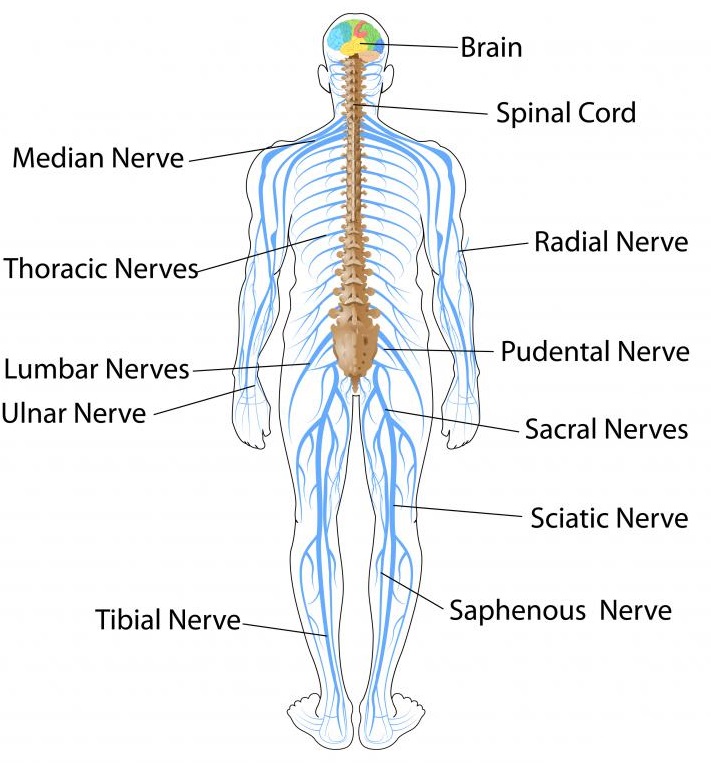
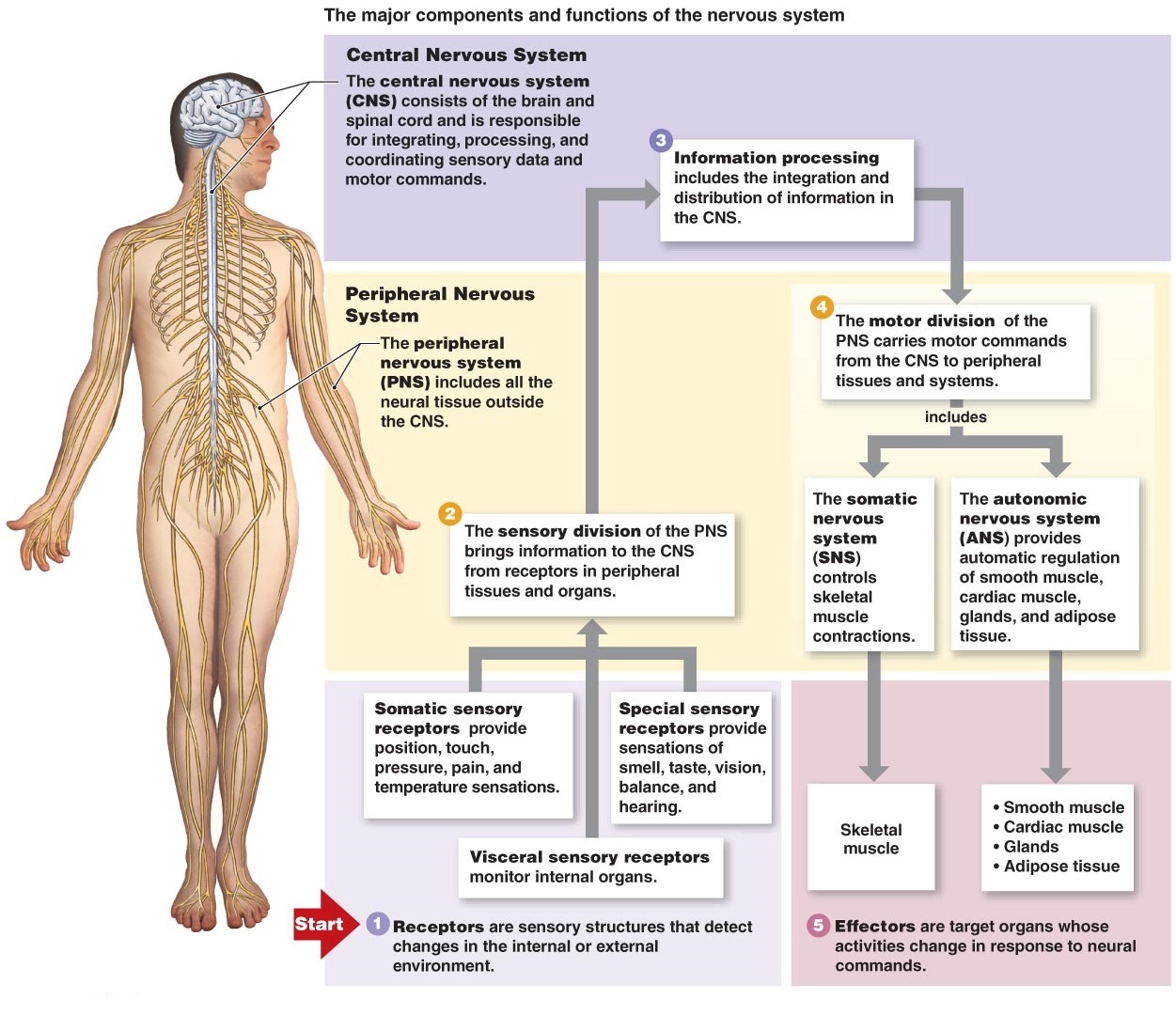
Question 2: Explain the divisions of nervous system.
Answer: The nervous system is divisible into three regions:
(i) Central nervous system: Includes brain and spinal cord.
(ii) Peripheral nervous system: Includes spinal and cranial nerves.
(iii) Autonomic nervous system: Includes the sympathetic and parasympathetic nerves.

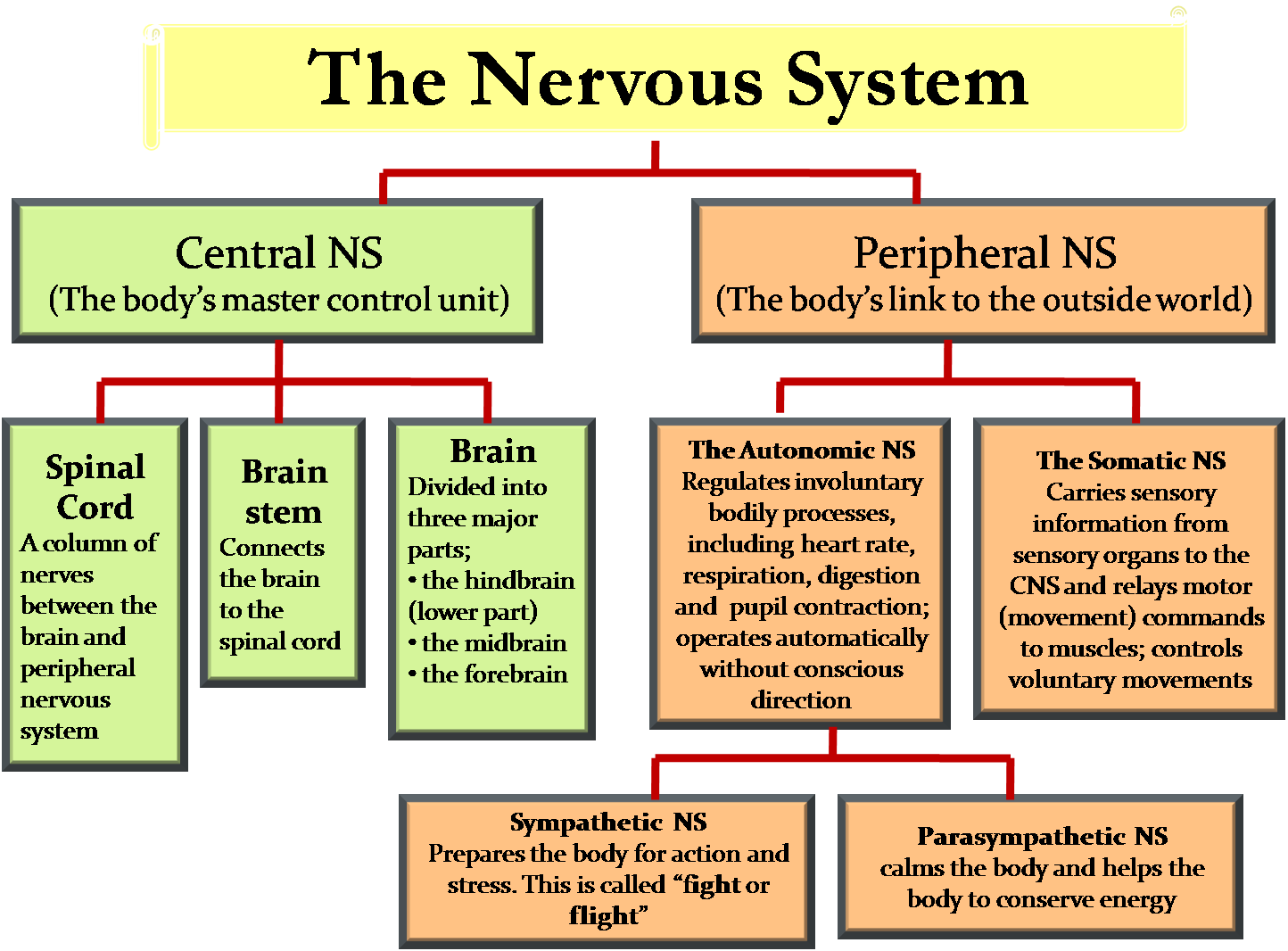
Question 3: Name three involuntary actions controlled by medulla in the hind brain.
Answer: Salivation, vomitting, blood pressure.
Question 4: Explain the terms sensory nerve, motor nerve and mixed nerve.
Answer: (i) A sensory nerve is one which sends nerve impulses from a receptor (sense organs) to the central nervous system.
(ii) A motor nerve is one which carries the impulses from the central nervous system to an effector.
(iii) A mixed nerve is one which carries both sensory and motor fibres. For example, a spinal nerve.
Question 5: What are the functions of tears ?
Answer: The functions of tears:
(i) To lubricate the surface of eye. (ii) To wash away dust particles.
(iii) To help in killing germs. (iv) To communicate emotions.
Question 6: Give the functions of spinal cord ?
Answer: (i) It controls all the reflex actions occurring below the neck.
(ii) It conducts sensory impulses from skin to the brain and motor impulses from brain to the muscles of trunk and limbs.
Question 7: How does the arrangement of nerve cells in the spinal cord differ from that in the brain ?
Answer: In spinal cord the cytons of the nerve cells forming gray matter is located in the interior of the spinal cord while in the brain gray matter is located in the exterior.
Question 8: How does an impulse travel across a synapse ?
Answer: The impulse travels across a synapse in one direction only, always from the axons to the cells — body and dendrites of the next neuron. Acetylcholine prevents its back flow.
Question 9: Name the part of the human brain which is concerned with the following :
(1) Seat of memory
(2) Coordinates muscular activity.
Answer: (1) Cerebrum
(2) Cerebellum.
Question 10: (i) What is meant by ‘reflex action’ ?
(ii) State whether the following are simple reflexes, conditioned reflexes, or neither of the two:
1. Sneezing. 2. Blushing. 3. Constriction of pupil.
4. Lifting up a book. 5. Knitting without looking.
6. Sudden application of brakes without thinking.
7. Blinking
8. Cleaning
9. Playing on the Keyboard
10. Salivation when food is put in the mouth.
Answer: (i) The reflex action is an immediate short-lived response to a stimulus, brought about by the nervous system.
(ii) 1. Simple reflex
2. Simple reflex
3. Simple reflex
4. None
5. Conditioned reflex
6. Conditioned reflex
7. Blinking—simple reflex
8. Cleaning of table—voluntary action
9. Playing on keyboard—conditioned reflex
10. Salivation when food is put in the mouth —simple reflex
Question 11: What type of reflexes are the following ?
(i) Sweating in summer, (ii) Knitting and swimming, (iii) Solving mathematical sums.
(iv) Formation of goose-pimples in cold weather. (v) Blinking of the eye.
Answer: (i) Simple reflex.
(ii) Conditioned and modified reflex.
(iii) Conditioned reflex depending upon reasoning and past experience.
(iv) Simple reflex.
(v) Simple reflex.
Question 12: In what two whys is yellow spot different from blind spot ?
Answer: Yellow spot has more cones and less rod cells. Blind spot has no photosensitive cells.
Question 13: What is a Lachrymal gland ?
Answer: Lachrymal gland is a secretary gland present in top right part of the eye. Its secretion is called tears which lubricates the eye and is antiseptic in nature.
Question 14: Name the common defects of the eye.
Answer: Common defects of the eye:
(i) Near or short sightedness (Myopia)
(ii) Far or long sightedness (Hypermetropia)
(iii) Astigmatism.
(iv) Presbyopia.
(v) Night blindness.
(vi) Colour blindness.
(vii) Squint.
(viii) Cataract.
Question 15: Mention the characteristics of the image that falls on the retina of the eye.
Answer: It is real, inverted and diminished.
Question 16: What is meant by power of accommodation of the eye ? Name the muscles of the eye responsible for the same.
Answer: The power of accommodation of the eye is the process of adjusting the focal length of the lens according to the near or distant objects. The ciliary muscles attached to the lens controls its curvature and alters its focal length.
Question 17: Name an old age eye defect. Why is it caused ?
Answer: Hypermetropia. It is caused due to flattening of eye lens (Also presbyppia in which lens looses flexibility).
Question 18: With reference to the functioning of the eye, answer the questions that follow:
(i) What is meant by power of accommodation of the eye ?
(ii) What is the shape of the lens during (1) near vision, (2) distant vision ?
(iii) Name the two structures in the eye responsible for bringing about the change in the shape of the lens.
(iv) Name the cells of the retina and their respective pigments which get activated (1) in the dark, (2) in light.
Answer: (i) It is the ability of the body to focus clearly objects, both close and distant from the eye.
(ii) 1. Almost round
2. Less convex almost flat
(iii) Ciliary muscles and suspensory ligaments.
(iv) 1. Rods, rhodopsin 2. Cones, iodopsin
Question 19: What are thermoreceptors ?
Answer: These receptors are located in the skin, help in detecting temperature changes. They are in the form of free nerve endings.
Question 20: What is stereoscopic vision ?
Answer: The capacity to perceive three-dimensional image due to simultaneous focusing of both eyes on a object is called stereoscopic (binocular) vision.
Question 21: What are the functions of proprioreceptors ?
Answer: These sense organs are present in the muscles. They detect position, movement of muscles, muscle tension, internal movement of organs etc.
Question 22: Describe the structure and location of various taste buds.
Answer: Structure of taste buds: There are four primary tastes-sweet, salty, sour and bitter. The taste receptors are called taste buds. Each taste bud opens on the tongue surface through a taste pore. Each taste buds contains 60-65 spindle-shaped cells, out of which 5-15 are taste receptor cells and others supporting cells. The taste receptor cells produce protoplasmic outgrowths called taste hair. The taste hair project through taste pore and receive the stimulus of taste.
| Taste buds | Location |
| Sweet | Front of the tongue |
| Salt | Tip and sides of the tongue |
| Bitter | Rear |
| Sour | Back and sides of the tongue |
Give Reasons
Question 1: The spinal cord and brain are called as the central nervous system.
Answer: Because they give rise to all the nerves and control all the actions of the body.
Question 2: Why injury to medulla oblongata results in death ?
Answer: Medulla oblongata controls involuntary functions like heart beat, rate of respiration, secretion of saliva gut peristalsis, etc. Injury to the Medulla oblongata may result to the stop of heart beat and breathing leading to death.
Question 3: Why do we see clearly at the central region of retina ?
Answer: The central region of the retina has fovea centralis, with the yellow spot area surrounding it. There are only cone cells responsible for clear vision and details of the objects.
Question 4: Older people require glasses to read and write.
Answer: In old age the flexibility of the lens declines and the lens becomes less convex or opaque leading to weakness of eye sight.
Question 5: Deficiency of vitamin A causes night blindness.
Answer: Because the visual purple (Rhodopsin) of the rods is not formed in the absence of vitamin A.
Question 6: When you enter into a dark room from bright because sunlight, you can not see things for a few second.
Answer: In bright light the visual purple or rhodopsin pigment is destroyed and the diameter of pupil is reduced to allow the entry of less light.
Question 7: The hand automatically shows the direction to turn a cycle without thinking.
Answer: Because of conditioned reflex which we learn by experience and gradually respond to it unconsciously.
Question 8: A person after consuming alcohol walks clumsily.
Answer: Alcohol affects the cerebellum which is the centre of body balance and co-ordination. Due to the alcohol effect the cerebellum is unable to co-ordinate muscular movements properly.
Differentiate
Question 1: A Sensory neuron and a Motor neuron (function)
Answer:
| Sensory Neuron | Motor Neuron |
| A sensory neuron sends nerve impulses to the central nervous system from the receptor organs. | A motor neuron sends nerve impulses from the central nervous system to the effector organs. |
Question 2: Cerebrum and Spinal cord (arrangement of neurons).
Answer:
| Cerebrum | Spinal cord |
| The inner portion of the cerebrum consists of white matter, mainly containing the axons (nerve fibres) of the neurons. | The inner portion of the spinal cord consists of gray matter containing the cell bodies, motor and associated neurons whereas the white matter forms outer layer. |
Question 3: Middle ear and Inner ear.
Answer:
| Middle Ear | Inner Ear |
| It has three ear ossicles and eustachian tube. | It has cochlea, urticulus, sacculae and semi- circular canals. |
| It transmits sound vibrations. | It is concerned with hearing, balance and equilibrium. |
Question 4: Short-sightedness and Long-sightedness.
Answer:
| Short-Sightedness | Long-Sightedness |
| (i) The inability of the eye lens to focus images of distant objects on the retina; so the images fall in front of the retina. | The inability of the eye lens to focus near object images on the retina; so the images fall beyond the retina. |
| (ii) It is corrected by using glasses of concave lens. | It is corrected by using glasses of convex lens. |
Question 5: Vitreous humour and Aqueous humour.
Answer:
| Vitreous Humour | Aqueous Humour |
| (i) It is found between the retina and the lens, posterior in the eye. | It is found between the cornea and the lens, anterior in the eye. |
| (ii) It has high specific gravity. | It has low specific gravity. |
Question 6: Yellow spot and Blind spot.
Answer:
| Yellow Spot | Blind Spot |
| (i) It has only cone cells. | It has neither cone cells nor rod cells. |
| (ii) Clear images are formed here. | No images are formed here. |
Question 7: Cochlea and Concha.
Answer:
| Cochlea | Concha |
| (i) It is a part of the inner ear. | It is the ear pinna of cartilage. |
| (ii) It contains the organs of hearing. | It collects the sound waves. |
Question 8: Rods and Cones.
Answer:
| Rods | Cones |
| These are neurons concerned with vision in poor light. | These are neurons concerned with detailed clear vision and colour perception. |
| They contain rhodopsin. | They have iodopsin. They don’t have rhodospin. |
Question 9: Retina and Choroid.
Answer:
| Retina | Choroid |
| (i) It is the innermost layer of the eye-ball. | It is the middle layer of eye ball tunics. |
| (ii) It contains neurons. | It contains blood capillaries. |
Question 10: Myopia and Hypermetropia.
Answer:
| Myopia | Hypermetropia |
| The lengthening of the eyeball or the lens is too curved causes this defect. | The shortening of the eyeball or flattening of the eye lens causes this defect. |
Question 11: Cerebrum and Cerebellum.
Answer:
| Cerebrum | Cerebellum |
| It is the seat of intelligence, memory and controls of voluntary activities. | It co-ordinates muscular activities and maintains body balance. |
Question 12: Afferent and Efferent Nerve.
Answer:
| Afferent (sensory) Nerve | Efferent (motor) Nerve |
| It conducts nerve impulse from periphery to the central nervous system. | It conducts nerve impulse from central nervous system (C.N.S.) to the periphery of the body. |
| It is generally made up of pseudo-unipolar neurons. | It is generally made up of multipolar neurons. |
| Its dendrites are comparatively longer than the axon. | Its axon is comparatively longer than dendrites. |
| Its axon enters into the C.N.S. | Its axon emerges out from C.N.S. |
Diagram Based Questions
Question 1: The following diagram is that of a human brain. Guidelines 1 to 5 indicate different parts of the surface of the brain and these are as follows:
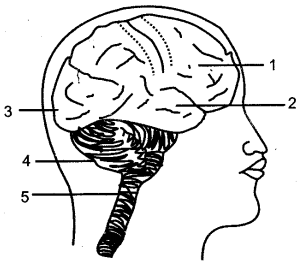
1. Frontal lobe of cerebrum
2. Temporal lobe of cerebrum
3. Occipital lobe of cerebrum
4. Cerebellum
5. Medulla oblongata
Study the diagram and answer the following questions:
(i) What handicaps would result from:
(a) Damage toçart numbered 3.
(b) Damage to part numbered 4.
(ii) Mention one main function of each of the parts numbered 1,2, and 5.
Answer: (i) (a) The part numbered 3 is named as occipital lobe of cerebrum, which is the area of vision. If this part is damaged, the person is unable to see.
(b) The part numbered 4 is named as cerebellum, which is responsible for coordinating the muscular activity for body balancing. If this part is damaged, the
body balancing during walking and running would be affected.
(ii) Function of part 1: It governs all mental activities (reason, will, memory, intelligence, higher feelings and emotions).
Function of part 2: It controls all voluntary action and is responsible for taste and smell.
Function of part 5: It controls several involuntary activities, such as heart beat, breathing, peristaltic motion of the alimentary canal, dilation and concentration of blood vessels, etc.
Question 2: The below diagram represents longitudinal section of human brain. Label its parts 1-9 as shown with guidelines.

Answer: 1. Cerebrum
2. Gray matter
3. White matter
4. Mid-brain
5. Cerebellum
6. Spinal cord
7. Medulla oblongata
8. Hypothalamus
9. Pituitary body
Question 3: The below simplified diagram shows a section through the brain.
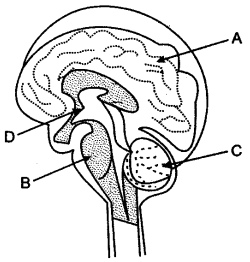
(i) Name the parts labeled A, B and C.
(ii) Give one function of each of the parts A, B and C.
(iii) What is found in region D?
Answer: (i) A—cerebrum; B—medulla oblongata; C—cerebellum.
(ii) a—controls memory, learning, speech and co-ordinates sensory input and motor output, b—controls vital processes such as heart rate and breathing, c—is
responsible for muscle co-ordination and balance.
(iii) D—contains cerebrospinal fluid.
Question 4: The below diagram represents the human brain as seen in an external view. Study the same and then answer the questions that follow:
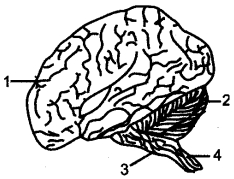
(i) Name the parts labeled 1, 2, 3 and 4.
(ii) Mention the difference in the arrangement of the nerve cells in the parts marked ‘1’ and ‘4’.
(iii) What is the main function of the parts marked ‘3’ and ‘4’?
(iv) Name the sheet of nerve fibres that connect the two halves of the part labeled ‘1’.
Answer: (i) 1. Cerebrum,
2. Cerebellum,
3. Medulla oblongata,
4. Spinal cord.
(ii) 1. Gray matter is outside and white matter inside.
4. White matter s outside and gray matter is inside.
(iii) 3. Medulla oblongata controls all involuntary movements of internal organs e.g., breathing movements of lungs, beating of heart.
4. Spinal cord performs reflex action below the neck.
(iv) Corpus callosum.
Question 5: The diagram given below shows the internal structure of the spinal cord, depicting a simple reflex. Study the same and then answer the questions that follow:
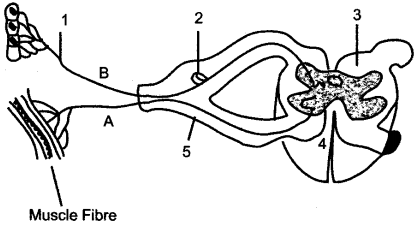
(i) Name the parts numbered 1 to 5.
(ii) Using the letters of the alphabet shown in the figure indicate the direction in which an impulse enters and leaves the spinal cord.
(iii) What is the term given to the point of contact between two nerve cells ?
(iv) What is meant by ‘simple reflex’ ? Give two examples of simple reflexes and name the stimuli too.
(v) How does the arrangement of nerve cells in the spinal cord differ from that in the brain ?
Answer: (i) 1. Sensory or Afferent fibre.
2. Cell body of sensory neuron.
3. White matter.
4. Cell body of motor neuron.
5. Spinal nerve.
(ii) BCA
(iii) Synapse.
(iv) Simple reflex: It is an involuntary automatic, quick response to a stimulus.
Examples: (a) The closing of the eyelids when a strong beam of light is flashed.
(b) The withdrawal of the hand when it is pricked.
(v) In spinal cord white matter is outside and gray matter is inside. In brain white matter is inside and gray matter is outside.
Question 6: The diagram given below represents the spinal cord of a mammal, seen in a transverse section together with the nerves. Study the diagram and then answer the questions given below:

(i) Label the parts 1—8 indicated by guidelines.
(ii) What do the arrows indicate ? What is the pathway indicated termed?
(iii) What type of nerve is shown in the diagram?
Answer: (i) 1. White matter
2. Gray matter
3. Dorsal root
4. Ventral root
5. Dorsal ganglion
6. Sensory neuron
7. Spinal nerve
8. Synapse
(ii) The arrows indicate the arrangement of white and gray matter is reversed from that in the brain. The patl4way indicated is termed as nervous pathway in a simple spinal reflex.
(iii) Sensory or Afferent nerve.
Question 7: The below diagram is the surface of tongue showing taste zone.

(i) Label the parts 1-4.
(ii) Where are the receptors for sensations of taste are located?
(iii) Why person suffering from cold often complain that they cannot taste their food?
Answer: (i) 1—Bitter Taste, 2—Sour Taste, 3—Salt Taste, 4—Sweet Taste.
(ii) The receptors for sensations are located in the taste bud covering the tongue surface.
(iii) Person suffering from cold often complain that they cannot taste their food because their gustatory sensations are not operating well.
Question 8: The diagram given below represents the cross-section of the human eye:
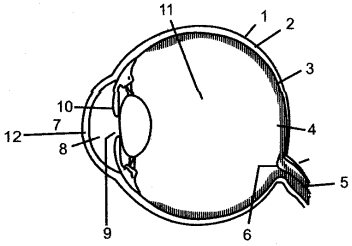
(i) Name the parts labeled 1—12.
(ii) What is the function of the part marked ‘10’?
(iii) What would happen if part ‘5’ is damaged or cut ?
Answer: (i) 1. Sclerotic
2. Choroid
3. Retina
4. Yellow spot or fovea
5. Optic nerve
6. Blind spot
7. Lens
8. Aqueous humour
9. Pupil
10. Iris
11. Vitreous humour
12. Cornea.
(ii) The function of the part marked ‘10’, the iris, is to regulate the amount of light that enters the eye so that too much light does not damage the delicate cells of the retina.
(iii) The person would not see because the sensations from the eye would not reach the brain.
Question 9: Given below is the diagram of a part of the human ear. Study the same and then answer the questions that follows:
Labyrinth of the inner ear.
(i) Give the biological term for Malleus, Incus and Stapes.
(ii) Name the parts labeled A, B and C in the diagram.
(iii) State the functions of the parts labeled ‘A’ and ‘B’.
(iv) Name the audio receptor region present in the part labeled. ‘A’.
Answer: (i) Ear Ossicles
(ii) A —> Cochlea, B —> Semi-circular canal, C —> Vestibule.
(iii) A is concerned with the sense of hearing. B is concerned with the sense of dynamic balance.
(iv) Organ of corti or spiral organ.
Question 10: The following diagram refers to the ear of a mammal.
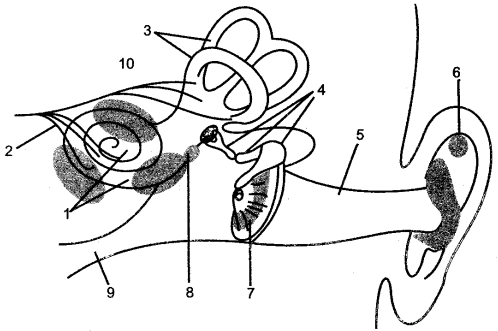
(i) Label the parts 1 to 10 to which the guidelines point.
(ii) Which structure:
(a) Converts sound waves into mechanical vibrations?
(b) Converts vibrations into nerve impulses?
(c) Responds to change in position?
(d) Transmits impulses to the brain?
(e) Equalizes atmospheric pressure and pressure in the ear.
Answer: (i) 1. Cochlea.
2. Auditory nerve.
3. Semi-circular canals.
4. Ear ossicles.
5. Auditory meatus.
6. Pinna.
7. Er drum.
8. Fenestra rotunda.
9. Eustachian tube.
10. Fenestra ovalis.
(ii) (a) Ear drum or tympanum.
(b) Organ of corti.
(c) Semi-circular canals.
(d) Auditory nerve.
(e) Eustachian tube.
Question 11: Given below is the diagram of the human ear. Study the same and answer the questions that follow:
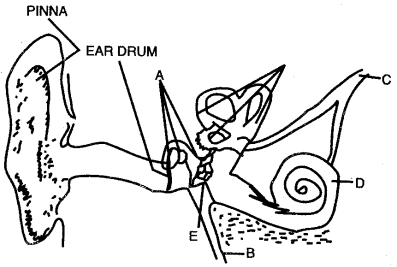
(i) Give the biological term for the part labeled ‘A’ and state its function.
(ii) Name the part labeled ‘B’ and state its function.
(iii) Name the part labeled ‘C’ and state its function.
(iv) Give the function of ear wax.
Answer: (i) Ear Ossicles (Malleus, incus and stapes)—To receive, magnify and transmit the sound vibrations to the membrane of the oval window.
(ii) Eustachian tube—It equalize the air pressure on either side of ear drum allowing it to vibrate freely.
(iii) Auditory Nerve—It transmits the impulses from cochlea to brain.
(iv) Ear wax-has insect repellent properties hence prevents the entry of insects in the auditory canal. It also checks die entry of dust particles in the ear. Thus, it lubricates and protects the ear drum.
Question 12: The diagram given below is a representation of a certain phenomenon pertaining to the nervous system. Study the diagram and answer the following questions:

(i) Name the phenomenon that is being depicted.
(ii) Give the technical term for the point of contact between the two nerve cells.
(iii) Write the functions of parts 5 and 6.
(iv) How does the arrangement of neurons in the spinal cord differ from that of the brain ?
Answer: (i) Reflex action
(ii) Synapse
(iii) (1) Sensory fibre
(2) Sensory ganglion
(3) White matter
(4) Grey matter
(iv) (5) It receives messages from sensory neuron and passes it to the motor neuron.
(6) It passes impulses from the spinal cord to the effector organ.
(v) In spinal cord the grey matter is inside and white matter is outside around it. In brain grey matter is outside and white matter is inside.
Question 13: Study the following diagram carefully and then answer the questions that follow. The diagram is depicting a defect of the human eye :
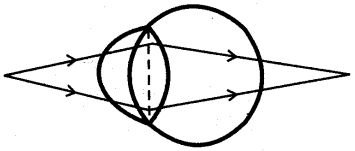
(i) Identify the defect shown in the diagram.
(ii) Give two possible reasons for the above defect.
Answer: (i) Far sightedness or hypermetropia.
(ii) (a) Lens is flattened or less convex,
(b) Eyeball is short.
Question 14: Given below is a diagram depicting a defect of the human eye. Study the same and then answer the questions that follows:
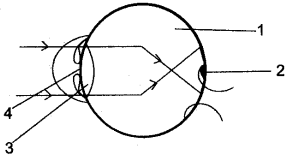
(i) Name the defect shown in the diagram.
(ii) Give two possible reasons for this defect of the eye in human beings.
(iii) Name the parts labeled 1 to 4.
(iv) Name the type of lens used to correct this eye defect.
Answer: (i) Myopia, Short-sightedness.
(ii) The possible reasons for this defect may be:
(1) The eyeball is lengtheied from front to back.
(2) The lens is too curved.
(iii) (1) Vitreous chamber.
(2) Fovea centralis (yellow spot)
(3) Lens
(4) Pupil.
(iv) This defect can be corrected by suitable concave lens.
Question 15: Given below is a diagrammatic representation of a defect of the human eye:

(i) Identify the defect.
(ii) Mention two reasons for the above defect.
(iii) State how the defect can be rectified.
(iv) Name the part of the eye responsible for maintaining the shape of the eyeball.
Answer: (i) Hypermetropia (Far-sightedness) because image is behind the retina.
(ii) Reasons for hypermetropia are:
1. Shortening of eyeball from front to back.
2. Lens becomes too flat.
(iii) It can be rectified by using convex lenses of appropriate power (focal Iength).
(iv) Sclerotic (or sclera).
Question 16: With respect to human eye explain:
(i) How is the image formed on the retina?
(ii) How is the amount of light entering the eye controlled?
(iii) What type of lens is used for the correction of ‘Long sight’ defect?
(iv) With the help of a ray diagram show the defect of the eye and then its correction after use of lens.
Answer: (i) Light from the source when reach the eye, it gets converged by the lens and an inverted image is formed on the retina.
(ii) The amount of light entering the eye can be controlled by dilating or constricting the pupil.
(iii) A biconcave lens is used to correct long sightedness.
(iv)
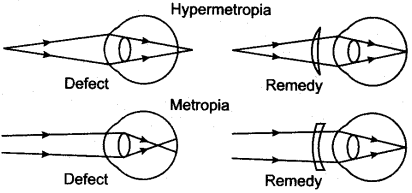
Question 17: Given below is the diagram of the human ear. Study the diagram and then answer the questions that follow :

(i) What role does the ear drum play in hearing?
(ii) What common term is given to the parts labeled A, B and E?
(iii) Would there be any difference if these three parts mentioned in (ii) above were replaced by one by one ? Why?
(iv) Give the biological term for the parts labeled C and D.
(v) Name the fluid which fills the parts mentioned in (iv) above.
(vi) State the functions of the ear.
Answer: (i) The ear drum is vibrated by sound waves and passes them to internal ear.
(ii) Ear ossicles.
(iii) One big ossicle would not be able to produce effective amplification because it would require a greater force of vibration that supplied by the ear drum normally. Moreover, three smaller ossicles with proper distance between their produces multiple amplification and effective transmission.
(iv) C is semi-circular canals and D is cochlea.
(v) Endolymph.
(vi) Hearing and balancing of the body.
Sketch and Label the Diagram
Question 1: Draw a neat labeled diagram to show how hypermetropia can be rectified.
Answer:
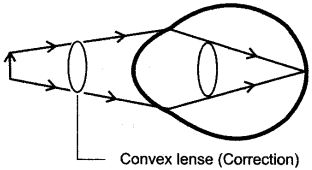
Question 2: Draw well labeled diagram of a ‘Neuron’ and name the following parts:
(1) Node of Ranvier (2) Nissil granules (3) Cyton
Answer:

Question 3: Draw a labeled diagram of a myelinated neuron.
Answer:
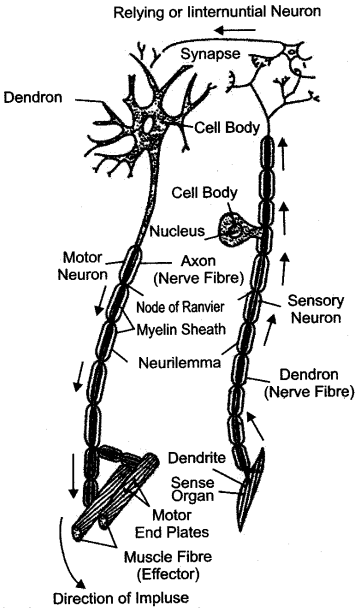
Question 4: Draw a diagram of the human eye as seen in a vertical section and label the parts which suits the following descriptions relating to the:
(i) photosensitive layer of the eye.
(ii) structure which is responsible for holding the eye lens in its position.
(iii) structure which mamtains the shape of the eye ball and the area of no vision.
(iv) anterior chamber seen in front of the eye lens.
(v) outer most transparent layer seen in front of the eye ball.
Answer:

Question 5: Draw a labeled diagram of the front view of human eye.
Answer:
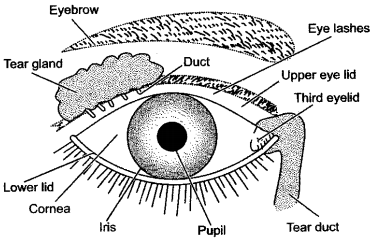
Question 6: Draw a labeled diagram of the inner ear. Name the part of the inner ear that is responsible for static balance in human beings.
Answer:
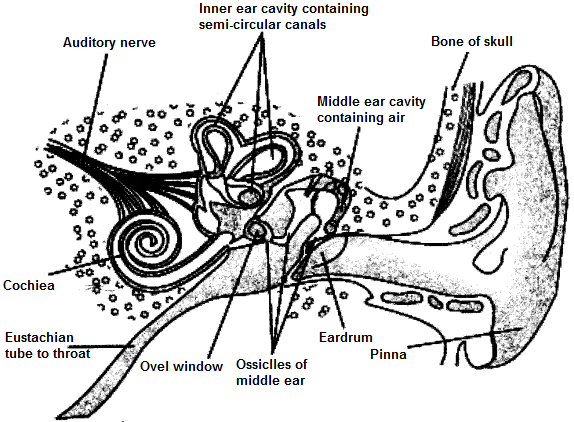
The static balance in the ear of human being is achieved by the gravity receptors located in the utriculus and sacculus in the inner ear.
Explain the Terms
Question:
1. Nerve
2. A Mixed nerve
3. Cyton
4. Ganglion
5. Voluntary-action
6. Synapse
7. Reflex action
8. Natural reflex
9. Accommodation in the eye
10. Hypermetropia
11. Presbyopia
12. Astigmatism
13. Cataract
Answer: 1. A nerve is a thread-like structure which emerges from the brain and the spinal cord. It consists of a large number of axons or nerve fibres surrounded by a connective tissue sheath. The nerves arising from the brain are called cranial nerves while those arising from the spinal cord, are called spinal nerves.
2. A mixed nerve is one which carries both sensory and motor fibres. For example, a spinal nerve. These’are mixed nerves and they have two separate connections with the spinal cord— (i) A dorsal root which is a sensory root, and (ii) A ventral root which is a motor root.
3. Cyton is the cell body of a nerve cell (neuron), containing cytoplasm and the cell organelles.
4. Ganglion is a small, solid mass of nervous tissue containing numerous cell bodies of a neuron.
5. The stimulation from the nerve cells of the receptor organ passes into the spinal nerve (along the dorsal root) into the spinal cord and from there it goes straight to the brain. From the brain another impulse passes, to the spinal cord and travels along the ventral root of the spinal nerve to reach the effector organ (a muscle), the activity of which is a response to the nerve impulse which has come from the brain.
6. Synapse is a place or a gap where two adjoining dendrites or axons meet but never unite, as there is no continuity between the nerve cells. At the synapse, acetylcholine is secreted which prevents back flow of the impulse.
7. Reflex action is an action which is nearly instantaneous and not under the control of the will. The impulse passes from the sensory cells of the receptor organ along the dorsal root into the spinal cord. From here two messages pass simultaneously—one to the brain and the other travels out along the ventral root to reach the muscle which immediately responds.
8. A natural reflex is the one in which no previous experience or learning is required and are inborn and protective, e.g., the sucking of milk of an infant from the breast of the mother or reflex of the eyelid.
9. Accomodation in the eye is the process of adjusting the eyes so that the image can be focused on the retina and seen clearly. This is done by altering the curvature of the lens by the contraction or relaxation of the ciliary muscles.
10. With age, the elasticity of the lens decreases and the individual becomes long- sighted and is called Hypermetropia In this condition, the diameter of the eyeball from front to back is too short. The clear image falls beyond the retina and the eye sees a blurred image. Hypermetropia may be corrected by the use of a biconvex lens.
11. Presbyopia: It is a condition affecting older people who cannot see near objects clearly. Their lens loses flexibility resulting in a kind of far-signtedness. This again is corrected by a convex lens.
12. Astigmatism: It is a defect in which some parts of the object are seen in focus while others are blurred. It arises due to the uneven curvature of the cornea. This is corrected by cylindrical lenses.
13. Cataract: It is a condition in which the lens turns opaque and the vision is cut down even to total blindness. It can be corrected by surgically removing the lens and by using spectacles with highly convex lense.
Name the Following
Question:
1. Unit of nervous system is.
2. The dorsal root ganglion of the spinal cord contain cell bodies of which type of neurons. –
3. Name the bony box in which the brain is located.
4. Protective membranes around brain.
5. The seat of memory and intelligence in the human brain.
6. The pigmented circular area seen in the eye.
7. The most sensitive region of the retina.
8. The innermost layer of the eye.
9. The focal length of the lens is altered by the contraction of which type of muscles.
10. The area where the image is formed but not seen by our eye is termed as.
11. The region in the eye where the rods and cones are located.
12. Yellow spot and ciliary muscles are found in.
13. The part of the eye responsible for change in the size of the pupil.
14. Fluid present in the posterior chamber of the eye.
15. The defect of the human eye caused due to the uneven surface of the cornea.
16. The type of lens used for correcting myopia.
17. Name the photoreceptors found in the retina of the eye.
18. The ear ossicle in contact with the oval window of the inner ear.
19. Name the three ear ossicles of the ear. How do they contribute in the mechanism of hearing ?
20. Name the three small bones present in the middle ear. What is the biological term for them collectively ?
21. Name the part of the ear associated with (1) static balance, (2) hearing, (3) dynamic balance.
22. Name the nerve, which transmits messages from the ear to the brain.
23. Give the technical term for the structure found in the inner ear.
Answer:
1. Neuron
2. Sensory
3. Cranium
4. Meninges
5. Cerebrum
6. Iris
7. Yellow spot
8. Retina
9. Ciliary muscles
10. Retina
11. Retina
12. Eye
13. Iris
14. Vitreous humour
15. Astigmatism
16. Biconcave
17. Rod cells and cones
18. Stapes
19. Three ear ossicles are : (i)Malleus (hammer), (ii)Incus (anvil), (iii)Stapes (Stirrup)
20. Malleus, incus, stapes. Collectively called ear ossicles.
21. (i) Vestibule, (ii) Cochlea, (iii) Semi circular canals
22. Auditory nerve
23. Membranous labyrinth
Give Technical Terms
Question:
1. The find cytoplasmic processes of the cell body of a neuron.
2. The neuron which conducts impulse from the central nervous system to the organs.
3. The brain and spinal cord together constitute the system known as.
4. The seat of intelligence and memory in the brain.
5. The part of human brain that controls body temperature.
6.. The structure which joins the two cerebral hemispheres in man.
7. The scientist, who conducted experiment on a dog to show conditioned reflex.
8. Response to a stimulus without the intervention of the will of an animal.
9. The chemical messenger by which the nerve impulse travels from one neuron to the other.
10. The number of cranial and spinal nerves in man.
11. The fluid that provides protection and nourishment to the cells of the brain.
12. Nerve that transfers impulses from ear to brain.
13. The part of the central nervous system in which the gray matter is located on the outer side and
the white matter on the inner side.
14. The junction between two nerve cells.
15. The fluid which fills the central canal of the spinal cord.
16. The path which responsible for protectingthe eye from sweat.
17. The type of lens used to correct myopia is
18. The part of the eye responsible for its shape.
19. What type of lens is used to correct ?
(a) Astigmatism (b) Myopia (c) Hypermetropia.
20. The most sensitive region of the retina.
21. What is the nature of the image that forms on the retina ?
22. The cells of the retina that are sensitive to colour.
23. Name the part of the retina on which an object is focused for the clearest vision.
24. The adjustment of the eye in order to obtain a clear vision of objects at different distances.
25. The receptors which help in the sensation of taste.
26. The fluid which conveys the vibrations of sound in the cochlea and semicircular canals.
27. The nutritive layer of the eye which also presents reflection of light.
Answer:
1. Dendrites
2. Motor neurons
3. Central nervous system
4. Cerebrum
5. Hypothalamus
6. Corpus callosum
7. Ivan Pavlov
8. Reflex action
9. Acetylcholine
10. Cranial nerves: 12 pairs, Spinal nerves :31 pairs
11. Cerebrospinal fluid
12. Auditory nerve
13. Brain
14. Synapse
15. Cerebrospinal fluid
16. Eye brows
17. Concave
18. Vitreous humour
19. (a) Cylindrical lens (b) Concave lens (c) Convex lens .
20. Fovea centralis or macula
21. Real, inverted and small in size
22. Cones
23. Yellow spot
24. Accommodation of eye
25. Sensory papillae
26. Endolymph
27. Choroid
Fill in the Blanks
Complete the following sentences with appropriate words :
1. There are Billion neurons in our body.
2. A bundle of axons enclosed in a tubular sheath is called Nerve.
3. Cerebrum is the largest part of the brain.
4. Cerebrum is the site of Memory/thinking.
5. The part of brain where the respiratory centre is located is Medulla oblongata.
6. The medulla oblongata is also known as the Spinal bulb.
7. A nerve chain between a receptor and an effector organ is called Reflex arc.
8. Optic nerve is a type Sensory nerve, whereas spinal nerves are mixed nerves.
9. An inability to focus on nearby objects due to loss of elasticity of the lens with age is called Iris.
10. The part of the central nervous system which responds to the reflex action is Spinal cord.
11. Ear is the organ of balance and hearing in the body.
12. Tympanic chamber is filled with Perilymph.
True & False
1. A nerve impulse passes from one neuron to another across a synapse. (True)
2. Spinal nerves and cranial nerves constitute the central nervous system. (False, Spinal nerves and cranial nerves constitute the peripheral nervous system.)
3. Cranium is & pdrtion of the brain. (False, It is a bony box, enclosed brain.)
4. Spinal nerves are twelve pair. (False, Spinal nerves are 31 pair.)
5. The nerve impulse in the eye develops due to the chemical changes brought about in the sensitive cells (rods and cones) by the light energy of the image. (True)
6. Reflex action involves brain. (False, Reflex action involves spinal cord.)
7. A reflex action is a spontaneous response to a stimulus. (False, A reflex action is a spontaneous involuntary response to a stimulus.)
8. Reflex action is a unit of nervous action. (True)
9. Cones are the receptor cells in the retina of the eye sensitive to dim light. (False, Cones are the receptor cells in the retina of the eye sensitive to bright light.)
10. Rods are responsible for vision in the dark. (True)
11. The least distance of distinct vision for the human eye is 25 cm. (True)
12. Hypermetropia is a defect of the eye caused due to the eyeball elongation. (False, Myopia is a defect of the eye caused due to the eyeball elongation.)
13. The part of ear associated with balance is the cochlea. (False, The part of ear associated with balance is the semicircular canal.)
14. Cochlea of the ear is concerned with the sense of balance. (False, Cochlea of the ear is concerned with the sense of hearing.)
15. Deafness is caused due to the rupturing of the pinna. (False, Deafness is caused due to the rupturing of the eardrum.)
State the Location
| Name | Location |
| Yellow spot | On the horizontal median axis of eye ball in retina. |
| Corpus callosum | Thick band of nerve fibres joining two cerebral hemisphere of cerebrum. |
| Incus | In middle ear inside tympanic activity. |
| Organ of Corti | In the cochlea of ear. |
| Pinnae | Side of the head, face. |
| Meninges | Covering of brain and spinal cord. |
| Lacrimal gland | At the upper side-ward portion of each eyelid. |
| Made of Ranvier | On the medullated neurons. |
| Ganglia | On each side of the spinal cord. |
| Cerebellum | In the hind brain. |
| Iris | In the eye behind the cornea. |
| Eustachian tube | Between the middle ear and pharynx. |
| Semicircular canals | In the internal ear. |
State the Function
Write the functional activity of the following structures:
| Name | Function |
| Cerebrum | Cerebrum is concerned with a number of senses like sight, hearing, taste, etc. The motor areas in the cortex give rise to voluntary movements such as speech, locomotion, etc. Other areas of the cerebrum are responsible for memory, intelligence, learning, emotions etc. |
| Hypothalamus | The hypothalamus of the mid-brain regulates the body temperature, smooth muscles activity, water balance, appetite, blood pressure and the metabolism of fats and carbohydrates. |
| Cerebellum | Cerebellum of the brain regulates and co-ordinates muscular contractions and skeletal movements. It is also concerned with balance. |
| Medulla oblongata | Medulla oblongata is concerned with certain vital activities such as respiratory movements, heart beat and the dilation of blood vessels. |
| Cornea | It covers and protects the iris and allows light rays into the eye. |
| Iris | It is a muscular screen made up of radial and circular muscles that control the diameter of the central opening—the pupil, according to the intensity of illumination. |
| Aqueous humour | It allows light rays to pass into the eye and prevents their refraction and dispersion. |
| Choroid coat in the eye | Choroid layer with many capillaries forms the nutritive layer of the eye. The extended choroid layer forms the pigmented muscular curtain called the iris. The aperture in the centre through which light enters the aperture is called the pupil. |
| Ear drum | It vibrates according to the sound waves and transmits them across the middle ear. |
| Ear ossicles | The vibrations of the ear drum are amplified and transmitted to the delicate membrane sketched along the oval window. |
| Myelin sheath | The myelin sheath covers the axon of a nerve cell, provides insulation and prevents indiscriminate distribution and leakage of nerve impulse. |
| Cerebrospinal fluid | Cerebrospinal fluid offers some protection to the brain and spinal cord by acting as a cushion to absorb shocks. It also supplies nourishment to the brain tissue. |
| Acetylcholine | When enough acetylcholine is secreted at the synaptic region of two nerve cells, it helps in the transmission of the nervous impulse to the next neuron under enzymatic reactions. |
| Cochlea | It contains the organ of corti—for receiving sound reception and transmits to the brain across the auditory nerve. It is the organ of hearing. |
| Semi-circular canals | They are concerned with maintaining equilibrium and posture of the body. |
| Endolymph | It transmits vibrations to the hair cells of the inner ear to produce acoustic perception. |
| Eustachian tube | It equalizes air pressure on the ear drum from inside. |
| Visual purple | It has vitamin A derivative that helps the eyes to see in dim light. |
| Conjunctiva | It binds the eye ball to the bony orbit of the skull and supplies nourishment. |
| Vitreous humour | It maintains the shape of eyeball. |
Choose the Odd One Out
1. Cyton, Photon, Axon, Dendrori. (Photon )
2. Cyton, Axon, Dendron, Cerebrum. (Cerebrum)
3. Coughing, Sneezing, Eating, Blinking. (Eating)
4. Corpus luteum, corpus calloswn, pens, cerebellum. (Corpus luteum)
5. Sneezing, coughing, blinking, typing. (Typing)
6. Cerebrum, Cranium, Cerebellum, Pons. (Cranium)
7. Sodium pump, Polared membrane, Threshold stimulus. (Sodium pump)
8 Pons, Cerebellum, Medulla Oblongata, Cerebrum. (Pons)
9. Choroid, Cilîary part, Iridial part, Cornea. (Cornea)
10. Rods, Cones, Night blindness, Rhodopsin. (Cones)
11. Myopia, Hypermetropia, Xerophthalnua.. Astigmatism. (Xerophthalmia)
12. Myopia, cataract, Hypermetropia, Squint, cretinism. (Cretinism)
13. Ciliar3’ muscle, Chords, Fovea, Gustatory cells. (Gustatory cells)
14. Incus, Pinna, Malleus, Stapes. (Pinna)
15. Semicircular canals, cochlea, Tympanum, Utriculus. (Tympanum)
16. Eustachian tube, Basilar membrane, Taste buds, Auditory ossicles. (Taste buds)
Multiple Choice Questions
1. The function of nervous system is to:
(a) Receive stimuli (b) Irritability.
(c) Conduction of enzymes (d) To prepare the body against reactions during emergency
2. A point of contact between wo neurons is termed:
(a) synapse (b) Sensory neuron
(c) neuro motor junction (d) Association neuron.
3. Neurilemma is:
(a) The cell membrane around the nerve cell
(b) A layer of fatty substance around axon.
(c) A layer of specialized neuroglia around myelin sheath of nerve fibres.
(d) The connective tissue around a nerve tract.
4. Cerebellum is the part of the brain which is responsible for:
(a) Interpreting sensations.
(b) Conducting reflexes in the body
(c) Maintaining posture and equilibrium.
(d) Controlling thinking, memory and reasoning.
5. If the cerebellum is injured:
(a) Movement’becómes shaky and speech become defective
(b) Movement becomes unbalanced, walk uncontrolled and speech defective
(c) Movement becomes jerky, walk controlled
(d) There is no effect as the actions are under the control of will.
6. The control of reflex action is through:
(a) Central nervous system
(b) Peripheral nervous system.
(c) Autonomic nervous system. (d) None of the above.
7. The ventral root ganglion of the spinal cord contains cell bodies of the:
(a) Motor neuron
(c) Intermediate neuron
(b) synapsis
(d) sensory
8. A reflex arc in man is bst described as movement of stimuli from:
(a) Receptor cell, sensory neuron, relaying neuron, effector muscles
(b) Receptor cell, efferent nervi, relaying neuron, muscles of the body
(c) Receptor cell, spinal cord, motor neuron, relaying neuron
(d) Receptor cell, synapse, motor neuron, relaying neuron
9. Which of the following is not a natural reflex action?
(a) Knee-jerk
(b) Blinking of eyes due to strong light
(c) Salivation at the sight of food
(d) Sneezing when any irritant enters the nose
10. The part of the human eye where rod cells and cone cells are located is the:
(a) Retina (b) Cornea
(c) Choroid (d) Sciera
11. The photo receptor cells of the retina sensitive to colour are:
(a) Cones (b) Pupil
(c) Rods (d) Organ of corti
12. The aperture in the eye through which light enters is the:
(a) Pupil (b) Conjunctiva
(c) Ciliary muscles (d) Choroid
13. The sequence of ear ossicles of vertebrates starting from the tympanum is:
(a) Incus, Malleus, Stapes (b) Stapes, Malleus, Incus
(c) Malleus, Incus, Stapes (d) Stapes, Incus, Malleus
14. The parts of the human ear concerned with hearing are :
(a) Cochlea,, ear ossicles and tympanum
(b) Semicircular canals, utriculus and sacculus
(c) Eustachian tube, tympanum and utriculus
(d) Perilymph, ear ossicles and semicircular canals
Match the Column
Column ‘II’ is a list of items related to ideas in Column ‘I’. Match the term in Column ‘II’ with the suitable idea given in Column ‘I’.
| Column I | Column II |
| (i) Auditory canal | (a) Channels pressure waves of air into the middle ear. |
| (ii) Auditory (Eustachian tube) | (b) Collects pressure waves of air. |
| (iii) Auditory nerve | (c) Converts pressure waves of air into vibrations of bone. |
| (iv) Incus | (d) Dissipates sound waves. |
| (v) Malleus | (e) Equalizes pressure between the middle ear and the atmosphere. |
| (vi) Oval window | (f) Provide information about the spatial orientation of the head. |
| (vii) Pinna | (g) Transfers vibrations from a bone to a fluid. |
| (viii) Round window | (h) Transfers vibrations from a bone to a membrane. |
| (ix) Semi-circular canal | (i) Transfers vibrations from a bone to a bone. |
| (x) Stapes | (j) Transfers vibrations from a membrane to a bone. |
| (xi) Tympanic membrane | (k) Transmits action potential to the auditory cortex. |
Answer: (i) (a) (ii) (e) (iii) (k) (iv) (i) (v) (j) (vi) (g) (vii) (b) (viii) (d) (ix) (f) (x) (h) (xi) (c)
ICSE Solutions for Class 10 Biology
- Cell Division Class 10 ICSE Questions and Answers
- Fundamentals of Genetics Class 10 ICSE Questions and Answers
- Absorption by Roots Class 10 ICSE Questions and Answers
- Transpiration Class 10 ICSE Questions and Answers
- Photosynthesis Class 10 ICSE Questions and Answers
- The Circulatory System Class 10 ICSE Questions and Answers
- The Excretory System Class 10 ICSE Questions and Answers
- The Nervous System and Sense Organs Class 10 ICSE Questions and Answers
- The Endocrine System Class 10 ICSE Questions and Answers
- The Reproductive System Class 10 ICSE Questions and Answers
- Human Population Class 10 ICSE Questions and Answers
- Physical Health and Hygiene Class 10 ICSE Questions and Answers
- Pollution Class 10 ICSE Questions and Answers
